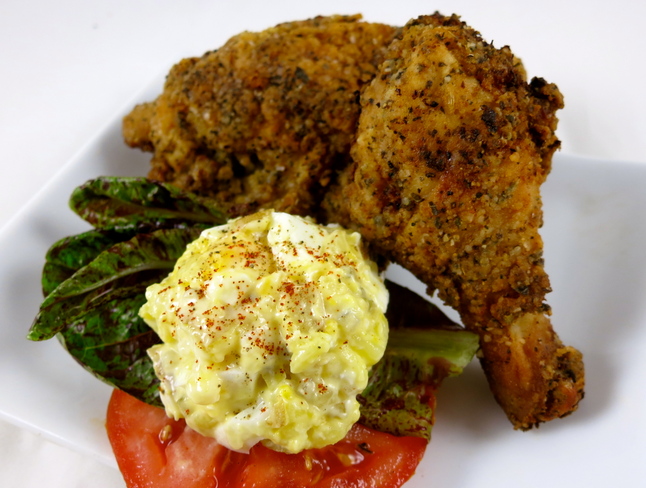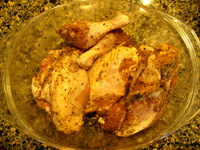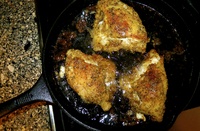Skillet Fried Chicken - careful technique yields tender but crisp bird

Skillet Fried Chicken
Peggy Lampman | Contributor
by email, sign up here.
With reluctance I’ve been working on a recipe for fried chicken, wondering why anyone needs another with Emeril Lagasse and Martha Stewart crowding the kitchen? That, however, is just a lame excuse; up until now my fried chicken has been only so-so.
Being able to make crisp and juicy fried chicken, seasoned just right, is not genetic. I grew up following generations of Alabama women who made outrageously delicious fried chicken at least once a week, but up until this recipe, I couldn’t make a batch that pleased my palate to save my life.

The secret is allowing pieces to rest in a savory rub with a last minute buttermilk splash.
When folks learned I was a food writer, raised in Alabama, they invariably said: “You must make great fried chicken.” Heat prickled my neck at this secret disgrace, and I always changed the subject: “Have you tried the fried chicken at Zingerman’s Roadhouse? It’s superb. Let’s go there for dinner.”
Sadly, not one of my family recipes was left behind; only the memory of my grandmother shoving sweet butter underneath the skin of one of her “yard walkers” before frying the bird in lard (and I’m still around to talk about it). I’m sure their recipes were not as complex as the one I’ve penned below; I doubt they even had a recipe to begin with. But here’s what I’ve learned.

A cast iron skillet distributes the heat evenly.
Using a well-seasoned, cast iron skillet’s a given. And I know for certain that no one on my family tree soaked chicken in buttermilk. But I love the tang the milk brings forward and began soaking mine a day in advance as so many recipes insist. The result was tangy and moist chicken with a lovely golden hue, but it wasn’t as crispy as Aunt Suelas’. Omitting the soak, dipping the pieces into the buttermilk before just frying, and adding cornstarch to the flour (per a Bon Appetit recipe) solved that problem.
Then there’s the heat of the oil and size of the chicken pieces; both need consideration or your chicken may burn before the flesh is cooked. Using a thermometer is foolproof, but I enjoy the art of “chicken whispering”. When frying chicken, it should sound like a steady patter of raindrops, not a torrential thunderstorm; like enthusiastic applause, never a thundering ovation.
Close to nirvana, I made another batch. What was that off-flavor about? I checked the expiration date of the flour that was hiding behind a jug of olive oil and, oops, should have been discarded a year or so ago; back to the frying pan. And here it is: my recipe for the best fried chicken I’ve made to date. At last I can look you in the eye if you want to talk chicken.
Yield: 4 servings (7-8 pieces chicken)
Time to rest in rub: 12-24 hours
Fry time: 35-45 minutes
Ingredients
1 tablespoon plus 1 teaspoon garlic powder
2 tablespoons crushed dried basil, divided
1 tablespoon plus 1/2 tablespoon kosher salt
2 tablespoons lemon pepper, divided
2 teaspoons cayenne, divided
3 1/2 pounds chicken pieces; bone-in, skin-attached*
1 large egg
1 cup lowfat buttermilk**
1 cup all-purpose, unbleached white flour
1 tablespoon cornstarch
Peanut oil or vegetable shortening, as needed
Several pats cold unsalted butter, for breasts (optional)
*Make sure the pieces are similarly sized and not too large; otherwise the chicken will burn before the meat is cooked through. Select chicken (particularly the breast) insuring the skin covers the flesh. I use air-chilled chicken: 3 split breasts, 2 thighs and 2-3 drumsticks.
**Full fat buttermilk makes the skin darken too soon. If you can’t find lowfat, mix 1/2 cup 2 percent milk with 1/2 cup buttermilk.
Directions
1. To make a rub, combine garlic powder with 1 tablespoon of the basil, 1 tablespoon of the salt, 1 tablespoon of the lemon-pepper and 1 teaspoon of the cayenne. Rub mixture over chicken; refrigerate, covered, at least 12 hours and up to 24.
2. Remove chicken from refrigerator and allow to come to room temperature; about 1 - 1 1 /2 hours.
3. In a large bowl, whisk egg into buttermilk. In a wide-mouthed, gallon-sized ziplock or baking dish, combine flour, cornstarch and remaining salt, basil, cayenne and lemon pepper.
4. Add enough fat to a 10- to 12-inch cast-iron skillet to 3/4-inch depth. Heat fat until a drop of flour sizzles in pan, or thermometer reads 300-325 degrees.
5. While fat is heating, dip chicken breasts in buttermilk mixture, allowing excess to drip back into the bowl. Dredge breasts in flour mixture, completely coating skin.
6. Loosen skin with fingers, and insert butter slices under skin, if desired. Place breasts, meaty side down, in hot oil and fry 11-15 minutes or until deep golden brown; adjust heat, if necessary, so it doesn't brown too quickly and occasionally move chicken with tongs, so chicken fries evenly. Flip chicken and cook an additional 10 minutes, or until meat is white at the bone (165 degrees). Lift chicken from skillet, letting excess oil drip back into skillet, then drain on a rack or triple layer of paper towels.
7. Place dark meat in flour and follow the same process as you did with breasts, except omit butter, if using. Let rest 15 minutes before serving.
Peggy Lampman is a real-time food writer and photographer posting daily feeds on her website and in the Food & Grocery section of Annarbor.com. You may also e-mail her at peggy@dinnerfeed.com.


